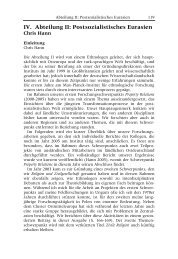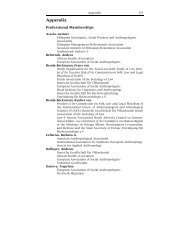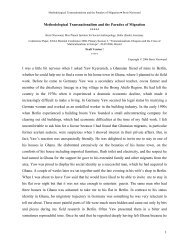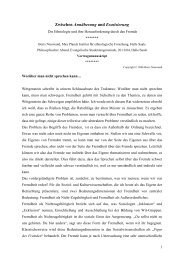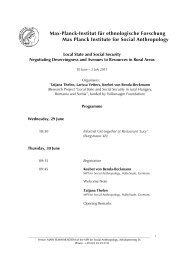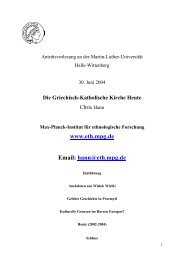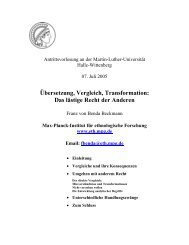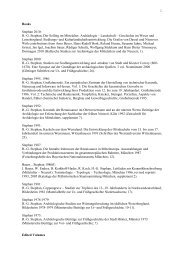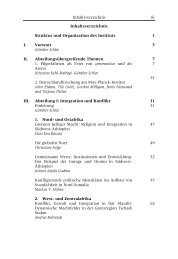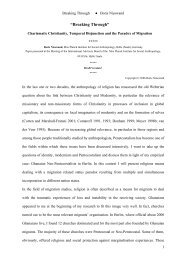Applying the Dhamma to contemporary society
Applying the Dhamma to contemporary society
Applying the Dhamma to contemporary society
Create successful ePaper yourself
Turn your PDF publications into a flip-book with our unique Google optimized e-Paper software.
Juth Pakai<br />
ISSN 1813-3622 New Thought Issue 7<br />
Perspectives<br />
on Lao development<br />
Minority education, Buddhism and<br />
development, dams and gender,<br />
Juth Pakai Issue 7<br />
47<br />
and local residents on <strong>to</strong>urism
Juth Pakai<br />
Issue 7 Oc<strong>to</strong>ber 2006<br />
Edi<strong>to</strong>rial 2<br />
Letter 3<br />
Education Improvement for Ethnic Children in <strong>the</strong><br />
Moksuk-Tafa Area<br />
Chithtalath Seng-Amphone<br />
<strong>Applying</strong> <strong>Dhamma</strong> <strong>to</strong> Contemporary Society:<br />
Socially-Engaged Buddhism and Development<br />
Work in <strong>the</strong> Lao PDR<br />
Patrice Ladwig<br />
Damming Lao Rivers: <strong>the</strong> Voices of Women<br />
Pafoualee Leechuefoung<br />
How Local Residents Perceive <strong>the</strong> Impact of<br />
Tourism Development<br />
Sengdeuane Wayakone<br />
36<br />
Glossary 44<br />
Sharing Information <strong>to</strong> Stimulate Development<br />
The Edi<strong>to</strong>rial Board of Juth Pakai firmly believes that <strong>the</strong> objectives of alleviating<br />
poverty and stimulating development in <strong>the</strong> Lao PDR will be better pursued<br />
if information and innovative thinking are shared. The articles presented here<br />
challenge our current way of thinking and/or contain information that has not<br />
yet been published. We sincerely hope that Juth Pakai will stimulate an active<br />
development debate and will contribute <strong>to</strong> a better understanding of <strong>the</strong><br />
development challenges in <strong>the</strong> Lao PDR.<br />
Juth Pakai Issue 7<br />
6<br />
6<br />
27
<strong>Applying</strong> <strong>Dhamma</strong> <strong>to</strong> Contemporary Society:<br />
Socially-Engaged Buddhism and Development Work<br />
in <strong>the</strong> Lao PDR<br />
by Patrice Ladwig<br />
Buddhism, an inherent part of Lao culture, has not often been considered an important<br />
source for improving <strong>the</strong> development process in <strong>the</strong> Lao PDR. This article analyses what<br />
Buddhism has <strong>to</strong> offer <strong>to</strong> <strong>the</strong> development process by looking at some of its traditional<br />
and emerging roles in <strong>society</strong>. This involves a short discussion of <strong>the</strong> concept of ‘social<br />
capital’ in relation <strong>to</strong> Lao Buddhism, followed by consideration of three current areas of<br />
social work that <strong>the</strong> clergy is involved in. After a brief presentation of <strong>the</strong> Buddhism for<br />
Development project, <strong>the</strong> conclusion refers <strong>to</strong> <strong>the</strong> advantages of integrating Buddhism<br />
in<strong>to</strong> some fields of development work, but also mentions a few inherent problems and<br />
limitations <strong>to</strong> this approach.<br />
What do Buddhism, and religion in general, have <strong>to</strong> do with development, which is still often considered<br />
a rational social engineering activity? Some people may associate religion with tradition, ritual and<br />
<strong>the</strong> o<strong>the</strong>r-worldly, whilst connecting development with science, planning and this-worldly activity.<br />
Although ‘culture’ is widely recognised as an important part of <strong>the</strong> development process, religion,<br />
though an inherent part of culture, has surprisingly very often not been considered an important<br />
source for improving <strong>the</strong> development process. However, <strong>the</strong> idea of linking religious organisations <strong>to</strong><br />
at least some particular parts of <strong>the</strong> development sec<strong>to</strong>r - and <strong>the</strong>reby moving <strong>to</strong>wards a development<br />
process that includes voices and discourses from within a culture - represents a powerful option not<br />
<strong>to</strong> be neglected.<br />
Regarding Laos, most people would agree that Buddhism plays an important role in everyday life for<br />
<strong>the</strong> majority Lao Loum people, and for some o<strong>the</strong>r Buddhist minorities. In order <strong>to</strong> conceptualise this<br />
importance, it is crucial <strong>to</strong> point out that Theravada Buddhism is not secluded from Lao <strong>society</strong> as a set<br />
of disconnected practices in monasteries. Ra<strong>the</strong>r, its values and ideas are present in <strong>society</strong>. Although<br />
many religious traditions are seemingly non-his<strong>to</strong>rical and mythical in nature, <strong>the</strong>y are constantly<br />
being reinterpreted in order <strong>to</strong> keep <strong>the</strong>m meaningful <strong>to</strong> <strong>the</strong> everyday lives of followers. Discontinuities<br />
within <strong>society</strong>, caused for example by rapid modernisation and <strong>the</strong> effects of globalisation, have often<br />
been <strong>the</strong> source of re-conceptualisation for religious teachings and have stimulated new forms of<br />
religiously inspired activism. In <strong>the</strong> case of Buddhism, this process has been labelled “socially-engaged<br />
Buddhism” (Queen & King, 1996). Prominent figures like Buddhadhasa Bhikkhu and Sulak Sivaraksa<br />
in Thailand, or Thich Nhat Hanh in Vietnam represent a diversity of movements that aim at extending<br />
and reformulating Buddhism’s role in modern <strong>society</strong>. They have called for a Buddhism that is rooted<br />
in tradition, but accepts <strong>the</strong> challenges of social transformation and gets more explicitly involved in<br />
social work, development issues, ecological movements and peace building, <strong>the</strong>reby contributing <strong>to</strong> <strong>the</strong><br />
6<br />
Juth Pakai Issue 7
construction of a just <strong>society</strong>. Their common denomina<strong>to</strong>r has been identification and implementation<br />
of teachings, practices and institutions that are applicable and potentially beneficial for development<br />
work in <strong>the</strong> broadest sense. This movement is perhaps most advanced in Thailand, where <strong>the</strong>re is a<br />
quite diverse array of ‘development monks’.<br />
In Laos <strong>the</strong>re have been some previous efforts <strong>to</strong> integrate Buddhist monks in<strong>to</strong> development work,<br />
but in a less systematic and organised way. However, <strong>the</strong> recent activism of a minority in <strong>the</strong> Sangha<br />
(Buddhist clergy) can be seen as an emerging socially-engaged Buddhism that is primarily driven by<br />
<strong>the</strong> rapid modernisation of <strong>the</strong> country. Although <strong>the</strong> Lao Sangha has for some time been involved<br />
in activities that could be labelled socially-engaged (Bousavath & Chapelier, 1973; Vichit, 2003), new<br />
initiatives are arising that aim <strong>to</strong> keep up with <strong>contemporary</strong> changes in Lao <strong>society</strong>: drug addiction,<br />
environmental degradation, prostitution, trafficking and migrant labour, and <strong>the</strong> increasing spread<br />
of HIV/AIDS are marking <strong>the</strong> late but intense arrival of modernity and globalisation in Laos. Most<br />
members of <strong>the</strong> Buddhist clergy have <strong>the</strong> conviction that <strong>the</strong> country’s modernisation is largely a<br />
positive development but also feel that <strong>the</strong> negative consequences present a challenge and sometimes<br />
a threat <strong>to</strong> Lao <strong>society</strong>. They believe that <strong>the</strong>y can influence <strong>the</strong>se developments in a positive way and<br />
actually have a responsibility <strong>to</strong> do so: from a Buddhist perspective, it is <strong>the</strong> monks’ duty <strong>to</strong> instruct<br />
<strong>the</strong> lay-population in Buddhist teachings and ethics, <strong>to</strong> give moral support and become engaged in<br />
activities that reduce dukkha (suffering). While discussing this <strong>to</strong>pic in 2004, <strong>the</strong> abbot of a Vientiane<br />
monastery explained, “dhamma [doctrine, teaching of <strong>the</strong> Buddha, law, nature or truth] is eternal, but<br />
<strong>the</strong> problems <strong>society</strong> encounters and <strong>the</strong> sources of suffering change. The sufferings in <strong>the</strong> time of <strong>the</strong><br />
Buddha were different in nature <strong>to</strong> <strong>the</strong> ones we encounter <strong>to</strong>day. Therefore it is crucial that we explain<br />
fundamental teachings again and set <strong>the</strong>m in relation <strong>to</strong> <strong>the</strong> everyday lives of people so we can help<br />
<strong>the</strong>m <strong>to</strong> understand dhamma and lead better lives” (personal communication, November 2004).<br />
Sangha Social Capital and Development Potential<br />
Classical anthropological studies on Lao Buddhism rarely fail <strong>to</strong> point out <strong>the</strong> central role that <strong>the</strong><br />
Buddhist temple plays in a village community. The important role monks play in village affairs,<br />
<strong>the</strong>ir influence on <strong>the</strong> lay people, and <strong>the</strong> Sangha’s institutional and personal network have often<br />
been represented as one of <strong>the</strong> main features of Lao communities. Condominas (1998), in a study on<br />
rural Lao Buddhism in <strong>the</strong> 1950s and 1960s, alludes <strong>to</strong> <strong>the</strong> multiple functions performed by <strong>the</strong> local<br />
pagoda (vat). Besides being a locus for religious rites, it can simultaneously act as a school, <strong>the</strong> village<br />
administration, local law court, feast hall, traditional hospital, guest house, counselling service, and<br />
general meeting place for <strong>the</strong> rural community. The temple is also <strong>the</strong> hub of a wide-ranging ritual<br />
economy of symbolic and monetary exchange. The vat can also be seen as linked <strong>to</strong> ‘distributive<br />
justice’ (Rawls, 1971) because of <strong>the</strong> collective investment of <strong>the</strong> lay-community in temple funds, used<br />
for example <strong>to</strong> educate novices from poor families. This embodies what many Lao people describe as<br />
khwamsamakhi (solidarity).<br />
Official Lao sources often speak of <strong>the</strong> intrinsic value of Buddhism beyond <strong>the</strong> pure spiritual and<br />
emphasise its ‘productive’ role in <strong>society</strong> (Phomvihane 1992; Vannasopha, 2003). While many of <strong>the</strong><br />
Juth Pakai Issue 7<br />
7
temple’s traditional tasks have been taken over by more specialised state institutions, thus redefining<br />
<strong>the</strong> role of Buddhism through ‘institutional secularisation’, in some areas <strong>the</strong> Sangha continues <strong>to</strong><br />
play an active and socially-engaged role (Vichit, 2003). Socially-engaged monks now deem it necessary<br />
<strong>to</strong> recognise what Buddhism could contribute <strong>to</strong> <strong>the</strong> development of <strong>contemporary</strong> Lao <strong>society</strong>. Hence,<br />
some members of <strong>the</strong> clergy are investigating <strong>the</strong> potential of Buddhist involvement and teachings <strong>to</strong><br />
develop ways of social activism.<br />
Buddhism has very strong notions of social ethics, both for monks and lay people (Rajavaramuni, 1990).<br />
Concepts such as responsibility, care, and striving for goodness are not only relevant for individuals but<br />
also for communities. The temple is still a centre of social activity where morality and Buddhist ethics<br />
are taught on holy days and where <strong>the</strong> village community meets for festivals. Monks have a particular<br />
significance in this context: with a duty <strong>to</strong> explain dhamma <strong>to</strong> lay people and care for <strong>the</strong>ir needs,<br />
<strong>the</strong>y are ascribed a special position in <strong>society</strong> and bes<strong>to</strong>wed with authority. Monks are highly respected<br />
members of <strong>the</strong>ir communities, clearly distinguished by lifestyle and everyday behaviour. They are<br />
regarded as having acquired knowledge that is beyond that of <strong>the</strong> normal villager and people often<br />
consult monks in moments of crisis and family problems. The practice of monks visiting schools and<br />
teaching about dhamma, Buddhist ethics and morality is now quite common in urban areas. These<br />
teachings are very much focused on traditional Buddhist <strong>to</strong>pics (learning <strong>to</strong> pray, respect for elders<br />
and teachers, value of education and Lao culture), but are nowadays becoming increasingly connected<br />
with <strong>to</strong>pics such as <strong>the</strong> environment and drug prevention.<br />
There is a wide range of Buddhist<br />
teachings that can be applied <strong>to</strong> ideas<br />
of sustainable development<br />
The preaching of dhamma is an asset that, when employed in a new context and geared <strong>to</strong>wards<br />
problems of <strong>contemporary</strong> <strong>society</strong>, can also influence people’s attitudes. Explaining dhamma is seen as<br />
an obliga<strong>to</strong>ry and meri<strong>to</strong>rious act for monks. Lay people listening <strong>to</strong> it also gain merit, while speeches,<br />
books and o<strong>the</strong>r discourses related <strong>to</strong> dhamma are a ‘gift of truth’. In regard <strong>to</strong> moral behaviour,<br />
monks should be an example for lay people. The monks’ ideal life-style, regulated by <strong>the</strong> vinai (rules of<br />
discipline), is an exemplary one based on moral conduct, purity, and compassion <strong>to</strong>wards all beings. For<br />
lay people <strong>the</strong>re are o<strong>the</strong>r Buddhist teachings like <strong>the</strong> noble eight-fold path (makhamiong phaed), <strong>the</strong><br />
ten perfections (sip pharamii), <strong>the</strong> four sublime states of mind (phromavihaan), and <strong>the</strong> avoiding of<br />
defilements (khiled). All <strong>the</strong>se teachings bear a relation <strong>to</strong> <strong>the</strong> amount of merit earned by an individual<br />
and can be seen as giving lay people a range of options <strong>to</strong> cultivate virtue. In this sense <strong>the</strong>y have a<br />
similar function <strong>to</strong> Michel Foucault’s idea of <strong>the</strong> “technologies of <strong>the</strong> self, which permit individuals<br />
<strong>to</strong> effect by <strong>the</strong>ir own means, or with <strong>the</strong> help of o<strong>the</strong>rs, a certain number of operations on <strong>the</strong>ir own<br />
bodies, souls, thoughts, conducts, and ways of being, so as <strong>to</strong> transform <strong>the</strong>mselves in order <strong>to</strong> attain<br />
a certain state of happiness, purity, wisdom, and perfection” (1997). In addition <strong>to</strong> <strong>the</strong>se hands-on<br />
Juth Pakai Issue 7
teachings, <strong>the</strong>re is also a wide range of more elaborate Buddhist doctrines that can be applied <strong>to</strong> ideas<br />
of sustainable development, for example environmental protection (Harris, 1995).<br />
If <strong>the</strong>se teachings and networks can be linked <strong>to</strong> current <strong>society</strong> and monks are capable of re-interpreting<br />
<strong>to</strong>pics like HIV, drugs, and environmental protection in <strong>the</strong> framework of traditional dhamma, <strong>the</strong>re<br />
is a significant opportunity <strong>to</strong> influence people’s behaviour and attitudes. The Buddhist Sangha, with<br />
its wide-reaching network and strong voice in <strong>the</strong> villages, has much that development specialists<br />
and anthropologists have labelled ‘social capital’. Putnam (2000) defines social capital as a multidimensional<br />
concept composed of a set of trust, social norms, networks and organisations that influence<br />
relations among people and are an asset for <strong>the</strong> individual and collective production of well-being.<br />
Social capital is also embedded in<strong>to</strong> social structure, for example in <strong>the</strong> form of kinship, work groups and<br />
<strong>the</strong> associated mutual obligations. It can also be found in religious communities and institutions (Greely,<br />
2001). In Laos this is visible in collective temple investments, temple committees and <strong>the</strong> activities of<br />
lay people and monks <strong>to</strong> maintain and improve temple buildings. Monks, due <strong>to</strong> <strong>the</strong>ir authority and<br />
wide networks, are in a unique position <strong>to</strong> articulate current social problems in <strong>the</strong> above-mentioned<br />
frame of Buddhist ethics. The use of Buddhist ethics presents an effective means of commenting upon<br />
issues like drug use and HIV because <strong>the</strong> monks can use an authoritative discourse-framework and a<br />
vocabulary that is sufficiently familiar <strong>to</strong> lay people, but at <strong>the</strong> same time leave room for integrating<br />
new developments in <strong>society</strong>.<br />
The following activities have a focus on <strong>contemporary</strong> social problems, or as some Lao monks would<br />
put it, ‘sources of suffering’. In different ways, each activity makes use of this or ano<strong>the</strong>r form of social<br />
capital in an attempt <strong>to</strong> appeal <strong>to</strong> basic Buddhist values, stimulate reflection on <strong>the</strong>se problems, and<br />
finally, change people’s behaviour and attitudes. Some of <strong>the</strong> activities are limited <strong>to</strong> <strong>the</strong> Vientiane area,<br />
while o<strong>the</strong>rs are <strong>to</strong> be implemented across <strong>the</strong> country. Their scope and <strong>the</strong> way <strong>the</strong>y are organised are<br />
very different; but <strong>the</strong>y all involve monks (and sometimes nuns) as <strong>the</strong> main agents and are geared<br />
<strong>to</strong>wards <strong>the</strong> needs of a lay population that is directly or indirectly confronted with <strong>the</strong>se problems.<br />
The Metta-Tham HIV/AIDS Project<br />
Although <strong>the</strong> official figures concerning HIV/AIDS prevalence are low in <strong>the</strong> Lao PDR – in 2005 <strong>the</strong>re<br />
were 1,827 reported HIV cases, 1,065 AIDS cases and 637 deaths from AIDS (Centre for HIV/AIDS/STIs,<br />
December 2005) – growth in cross-border trade and <strong>the</strong> number of migrant workers means <strong>the</strong><br />
Juth Pakai Issue 7<br />
Monks, due <strong>to</strong> <strong>the</strong>ir authority and wide<br />
networks, are in a unique position <strong>to</strong><br />
articulate current social problems<br />
Sangha Involvement: Three Examples
chances of a future epidemic are growing. One of <strong>the</strong> biggest challenges <strong>to</strong> preventing this is <strong>the</strong> lack<br />
of knowledge among <strong>the</strong> Lao population: in 2001 about one-third of Lao women had never heard of<br />
HIV/AIDS. The ‘Buddhist Leadership Initiative’ is an alliance of nuns and monks who have established a<br />
network in various Sou<strong>the</strong>ast Asian countries in order <strong>to</strong> take a leading role in HIV-care and prevention<br />
at <strong>the</strong> community level. The programme is sponsored by Unicef and is carried out on a low-cost basis.<br />
Activities include HIV-prevention seminars and talks, spiritual counselling for infected people, and<br />
provision of daily necessities for those with <strong>the</strong> disease who are no longer able <strong>to</strong> earn <strong>the</strong>ir own living<br />
(Unicef, 2003). The infrastructure used is <strong>the</strong> one already established by <strong>the</strong> Sangha – a network of<br />
nuns, monks, temples and committees all over <strong>the</strong> country.<br />
The Lao Sangha joined <strong>the</strong> programme in September 2001 and held, <strong>to</strong>ge<strong>the</strong>r with representatives of<br />
<strong>the</strong> Religious Affairs Department of <strong>the</strong> Lao National Front for Reconstruction and leading monks of<br />
<strong>the</strong> Lao Buddhist Fellowship Organisation (LBFO), an orientation training workshop for 80 monks<br />
and nuns, followed by introduction training for pupils from <strong>the</strong> Buddhist College at Vat Ong Tu. The<br />
project now has a permanent office in Vientiane and a few monks are professionally participating on<br />
a long-term basis. The base out of which <strong>the</strong> concepts and actions for <strong>the</strong> programme arise are firmly<br />
rooted in Buddhist dhamma. Buddhist ethics and teachings like <strong>the</strong> five precepts, and values like<br />
moderation, self-discipline and compassion are evoked when conveying <strong>the</strong> messages <strong>to</strong> lay people.<br />
The concrete objectives of <strong>the</strong> programme include:<br />
•<br />
•<br />
•<br />
20<br />
Reducing <strong>the</strong> level of discrimination experienced by people living with HIV. If infected<br />
people are isolated in <strong>the</strong>ir communities, monks should adapt key Buddhist teachings<br />
such as compassion (metta), kindness (khalunaa) and equanimity (upekkha) <strong>to</strong><br />
undermine discrimina<strong>to</strong>ry behaviour <strong>to</strong>wards infected people. They should also point out<br />
that discrimina<strong>to</strong>ry and excluding behaviour creates considerable negative karma (baab),<br />
while showing compassion and helping are wholesome and meri<strong>to</strong>rious actions (boun).<br />
Encouraging monks <strong>to</strong> make direct contact with HIV-infected people. In order <strong>to</strong> show<br />
leadership in non-discrimination, monks should make regular visits <strong>to</strong> families of HIVinfected<br />
people. Monks can also offer counselling services, pre-death counselling, meditation<br />
instruction, protection-threads or blessing rituals for <strong>the</strong> well-being of infected people. It<br />
should also be ensured that people who die from AIDS get a full Buddhist funeral.<br />
Community HIV-prevention education delivered by <strong>the</strong> local Sangha. Monks should<br />
incorporate HIV education messages in temple teachings and sermons. They are also<br />
supposed <strong>to</strong> visit local schools and give simple explanations on social issues including<br />
HIV and drug abuse, and should reiterate relevant basic Buddhist teachings such as <strong>the</strong><br />
precepts as often as possible.<br />
Currently monks primarily focus on prevention and fighting discrimination. The project is currently<br />
active in Vientiane, Savannakhet, Champassak, Luang Prabang and Bokeo provinces. In <strong>the</strong> o<strong>the</strong>r<br />
provinces monks still lack training and experience. From a general perspective it must be said that a<br />
project on this scale is challenging for both monks and lay people, as it is supposed <strong>to</strong> combine modified<br />
traditional teachings with concrete actions. Some of <strong>the</strong> problems that came up during implementation<br />
will be discussed in <strong>the</strong> final chapter.<br />
Juth Pakai Issue 7
Drug Prevention and Social Work<br />
Drug abuse among teenagers is a growing problem, mainly in urban areas of Laos. Besides legal<br />
drugs such as alcohol and cigarettes, <strong>the</strong> major concern is <strong>the</strong> use of meta-amphetamines (ya ba).<br />
The Sangha has become active in prevention campaigns in connection with a nationwide campaign<br />
against drug abuse. Activities include going in<strong>to</strong> schools and talking about dhamma, lifestyle, and<br />
<strong>the</strong> harmful effects of drugs on mind and body. The author observed monks using lively and inclusive<br />
teaching methods that differed from <strong>the</strong> usual <strong>to</strong>p-down approach. Frequent reference was made <strong>to</strong><br />
<strong>the</strong> fifth precept, “refrain from in<strong>to</strong>xicants causing carelessness”, and <strong>the</strong> problems and reasons that<br />
lead <strong>to</strong> taking drugs were discussed.<br />
Warnings against drugs are sometimes mentioned in sermons on festival days. For a <strong>society</strong> in which<br />
a lot of knowledge transfer still occurs through <strong>the</strong> medium of s<strong>to</strong>ry telling, <strong>the</strong>se are a very effective<br />
means of spreading information. Besides offering good entertainment and occasions for making merit,<br />
temple festivals are also opportunities <strong>to</strong> spread messages and <strong>to</strong> engage people in awareness raising<br />
and prevention work by stimulating discourse and reflection. The functions that narrative performances<br />
can have tend <strong>to</strong> be underestimated by outside observers: in Lao and Buddhist notions of language,<br />
<strong>the</strong> meri<strong>to</strong>rious acts of listening and preaching form a highly educative ethical activity (Hallisey &<br />
Hansen, 1996). For <strong>the</strong> message <strong>to</strong> be unders<strong>to</strong>od however, a precondition is that <strong>the</strong> preacher’s style<br />
is understandable <strong>to</strong> lay people and avoids excessive use of specialist Pali vocabulary. Many monks<br />
now emphasise this.<br />
In addition <strong>to</strong> <strong>the</strong> project carried out with an international agency (Unicef) and <strong>the</strong> drug prevention<br />
work, which is often an ad hoc initiative by individual temples, <strong>the</strong>re is also now a small group of<br />
Buddhist monks and lay people aiming <strong>to</strong> give socially-engaged Buddhism in Laos an organisational<br />
and institutional structure. The government (in <strong>the</strong> form of <strong>the</strong> LBFO and <strong>the</strong> Lao National Front for<br />
Reconstruction) has approved <strong>the</strong> establishment of <strong>the</strong> ‘Buddhism for Development Project’ (BFD).<br />
For a few years now this group has been mainly engaged in ecological preservation work, but also in<br />
a wide range of o<strong>the</strong>r aspects of socially-engaged Buddhism, sometimes in cooperation with <strong>the</strong> Lao<br />
Participa<strong>to</strong>ry Development Training Centre, PADETC. Projects include <strong>the</strong> establishment of tree nurseries,<br />
campaigns against harmful chemical fertilisers, and production of a booklet on <strong>the</strong> disappearance of<br />
wildlife, in cooperation with <strong>the</strong> Wildlife Conservation Society (WCS, 2004). Toge<strong>the</strong>r with a British<br />
secular organisation, <strong>the</strong> Alliance for Religion and Conservation (ARC), <strong>the</strong> group recently compiled an<br />
Environmental Handbook for Monks Teaching in Primary Schools <strong>to</strong> combine traditional Buddhist<br />
Juth Pakai Issue 7<br />
In a <strong>society</strong> in which much knowledge is<br />
transferred through s<strong>to</strong>ry telling, sermons are<br />
very effective in spreading information<br />
Buddhism and Ecology: <strong>the</strong> Buddhism for Development Project<br />
2
teachings with environmental awareness. The monks involved regularly visit local schools <strong>to</strong> promote<br />
environmental education. BFD also plans <strong>to</strong> turn some forest temples in<strong>to</strong> ecologically protected areas<br />
and <strong>to</strong> generally promote a way of ‘Buddhist agriculture’ (phuthakhased).<br />
Most of <strong>the</strong>se activities are part of a larger LBFO three-year training programme that involves a core<br />
group of more than 60 monks from all provinces in Laos. Besides instruction in traditional tasks<br />
such as meditation and dhamma studies, <strong>the</strong> objective is <strong>to</strong> train both monks and lay people <strong>to</strong><br />
become ‘community development leaders’. Its goal is <strong>to</strong> “incorporate Buddhist wisdom with social<br />
work, especially at <strong>the</strong> grassroots level” (BFD, 2004). One of <strong>the</strong> training modules lists <strong>the</strong> following<br />
objectives:<br />
•<br />
•<br />
•<br />
•<br />
•<br />
•<br />
•<br />
22<br />
Understand complex <strong>contemporary</strong> social issues locally, regionally and globally;<br />
Give a sustainable perspective on community development;<br />
Ensure cultural integrity in communities;<br />
Learn how <strong>to</strong> apply Buddhist values in sustainable development;<br />
Develop necessary skills for empowerment in community organisations;<br />
Train local resource people for community action with a Buddhist approach;<br />
Stimulate social analysis and gender awareness.<br />
BFD representatives are just beginning <strong>to</strong> develop a specific Lao approach <strong>to</strong> socially-engaged Buddhism.<br />
The group’s leading monk, <strong>the</strong> Venerable Achan Sali Kantasilo explained that <strong>the</strong> group is in <strong>the</strong><br />
early stages of its development and that a sustainable group structure is still in <strong>the</strong> process of evolving<br />
(personal communication, May 2005). It will take ano<strong>the</strong>r few years before <strong>the</strong> efficiency of <strong>the</strong> training<br />
and <strong>the</strong> implementation of <strong>the</strong> strategies learnt can be evaluated. Its success will also depend on how<br />
<strong>the</strong>se new ideas will be received in <strong>the</strong> Lao context and how <strong>the</strong>y can really be linked <strong>to</strong> dhamma as it<br />
is unders<strong>to</strong>od by a laity that until now had little or no exposure <strong>to</strong> <strong>the</strong>se ideas. One of <strong>the</strong> great assets<br />
of <strong>the</strong> group is that it aims at developing a coherent approach <strong>to</strong> development issues, training monks<br />
in relevant subjects and <strong>the</strong>reby giving <strong>the</strong>m a firm grounding. The focus on <strong>the</strong> grassroots level and<br />
<strong>the</strong> plan <strong>to</strong> spread <strong>the</strong>se ideas in <strong>the</strong> provinces once <strong>the</strong> monks have completed <strong>the</strong>ir training is also<br />
important. The project has so far been on a very small scale, but it could have a synergetic effect as it<br />
is based on low-cost sustainability, direct involvement of focal temples, and <strong>the</strong> integration of young<br />
lay people in<strong>to</strong> <strong>the</strong> programme.<br />
Limitations and Caveats<br />
The three above-mentioned projects show that a minority within <strong>the</strong> Lao Sangha is taking an active<br />
stance in relation <strong>to</strong> current social problems. It is making an effort <strong>to</strong> practise a kind of Buddhism rooted<br />
in traditional dhamma, but is also attempting <strong>to</strong> contribute <strong>to</strong> solving predicaments in Lao <strong>society</strong>.<br />
The way <strong>the</strong>se projects will initiate o<strong>the</strong>r activities and will fur<strong>the</strong>r social development is very much<br />
dependent on <strong>the</strong> internal structure and capacities of <strong>the</strong> Sangha and <strong>the</strong> wider field it operates in.<br />
Juth Pakai Issue 7
The present involvement of monks is primarily based on <strong>the</strong>ir general authority and influence in <strong>the</strong>ir<br />
communities and among lay people. The social capital monks have is an excellent resource that can<br />
be tapped <strong>to</strong> disseminate information and carry out prevention work on a whole range of development<br />
issues. A substantial number of Lao monks are aware of current problems in <strong>society</strong> and are keen <strong>to</strong><br />
perform duties that could include activities rooted in Buddhist teachings, but which involve an expansion<br />
of <strong>the</strong>ir traditional role. However, <strong>the</strong> creation of human resources within <strong>the</strong> Sangha is problematic,<br />
as basic skills like writing proposals, planning, implementation and moni<strong>to</strong>ring are largely absent.<br />
The Sangha does not have <strong>the</strong> resources and experience <strong>to</strong> carry out training and nei<strong>the</strong>r <strong>the</strong> Lao<br />
government nor most international organisations (except Unicef, ARC, and WCS) have shown much<br />
interest in enhancing <strong>the</strong>se capacities. Within <strong>the</strong> Lao clergy, only BFD has a more multifaceted plan<br />
(but not really <strong>the</strong> funds) <strong>to</strong> build up <strong>the</strong>se capacities. The Buddhist College at Vat Ong Tu would be a<br />
place where <strong>to</strong>pics like social development and social work could be taught, but at <strong>the</strong> moment it has<br />
nei<strong>the</strong>r <strong>the</strong> funds nor <strong>the</strong> experience <strong>to</strong> expand its programme and include modules on <strong>the</strong>se subjects<br />
in its curricula.<br />
Juth Pakai Issue 7<br />
Monks do not directly address <strong>the</strong> <strong>to</strong>pic of<br />
HIV, but work <strong>to</strong>ge<strong>the</strong>r with lay people who<br />
talk about <strong>the</strong> more explicit matters<br />
It must also be mentioned that not all monks or lay people are really convinced that <strong>the</strong>se new roles<br />
are part of clerical duties. A minority would prefer <strong>the</strong> Sangha <strong>to</strong> stay in its original field and not take<br />
on tasks that could be linked <strong>to</strong> social work or any o<strong>the</strong>r more active involvement in <strong>society</strong>. When<br />
monks get involved in ‘worldly’ projects <strong>the</strong>re is always a fear that <strong>the</strong>y might lose <strong>the</strong>ir detachment<br />
and so violate <strong>the</strong> monastic code of discipline. Orthodox opponents of socially-engaged Buddhism<br />
in Thailand have used this argument <strong>to</strong> strictly demarcate Buddhism’s role in <strong>society</strong> and call for a<br />
return <strong>to</strong> an ‘original’ Buddhism that keeps a distance from worldly affairs. In <strong>the</strong> Lao HIV-prevention<br />
project, <strong>the</strong>re was a fear that <strong>the</strong> <strong>to</strong>pic could be problematic in relationship <strong>to</strong> <strong>the</strong> code of discipline. A<br />
compromise was found: monks do not directly address <strong>the</strong> <strong>to</strong>pic of HIV, but work <strong>to</strong>ge<strong>the</strong>r with lay people<br />
(mainly urban youth volunteers from <strong>the</strong> Lao National Front for Reconstruction) who talk about <strong>the</strong><br />
more explicit matters involved. The monks focus on <strong>the</strong> Buddhist values that are supposed <strong>to</strong> give rise<br />
<strong>to</strong> reflection on HIV-related <strong>to</strong>pics. In this case, it is more a problem of finding <strong>the</strong> right framework for<br />
<strong>the</strong> reinterpretation of Buddhist teachings, ra<strong>the</strong>r than being a ‘yes or no’ situation. The special rules<br />
of behaviour for monks, which are <strong>the</strong> source of <strong>the</strong>ir authority, can in most cases be negotiated and<br />
contextualised and <strong>the</strong>refore made applicable <strong>to</strong> development work. Never<strong>the</strong>less, <strong>the</strong> involvement of<br />
monks demands a careful and reflective planning process.<br />
Also in <strong>the</strong> Metta-Tham project, it became clear that despite <strong>the</strong> enthusiasm shown primarily by younger<br />
monks, <strong>the</strong>re is often simply a lack of experience in how <strong>to</strong> approach a new engagement. Most people<br />
attending <strong>the</strong> training sessions in <strong>the</strong> affected villages showed very positive reactions; but a minority of<br />
23
lay people and some of <strong>the</strong> more conservative senior monks aired criticism and were pessimistic about<br />
<strong>the</strong> clergy’s involvement. Most senior figures of <strong>the</strong> Sangha were enthusiastic, but acknowledged that<br />
<strong>the</strong>y have a lack of experience in responding <strong>to</strong> HIV/AIDS. They felt that <strong>the</strong>y were not aware of all <strong>the</strong><br />
options this work could involve and lacked <strong>the</strong> organisational skills <strong>to</strong> carry out some of <strong>the</strong> proposed<br />
actions. In response <strong>to</strong> this, Unicef evaluated <strong>the</strong> achievements after <strong>the</strong> first year and <strong>the</strong>n suggested<br />
how <strong>the</strong> programme could be enhanced (Unicef, 2003a). Some of <strong>the</strong> points mentioned in <strong>the</strong> report<br />
are exemplary for working with a Sangha that has little experience with social activism and direct<br />
engagement. Monks initially focused on preaching and did not really establish contact with infected<br />
people. While younger monks were really enthusiastic, older monks and abbots sometimes showed little<br />
or no interest in <strong>the</strong> new activities. In many cases it was observed <strong>the</strong>re was no real understanding of<br />
how and why monks should get involved in social work (ibid). Reaching <strong>the</strong> target audience was also<br />
a problem. Most people attending temple festivals are over 50 years of age. To counter this development,<br />
<strong>the</strong> LBFO has set up an ‘Ordination Project’ that organises temporary one-week ordinations for boys<br />
and girls in <strong>the</strong> Vientiane area, combined with training in Buddhist values and ethics and including<br />
HIV- and drug-prevention.<br />
The age, experience and suitability of <strong>the</strong> Lao Sangha for this kind of work is ano<strong>the</strong>r important fac<strong>to</strong>r<br />
that limits its potential. The clergy is largely composed of novices and monks who leave <strong>the</strong> temple<br />
after completing <strong>the</strong>ir education. As a ‘religious boarding-school’ it gives a lot of young males from<br />
<strong>the</strong> countryside <strong>the</strong> chance <strong>to</strong> obtain a higher education - an opportunity <strong>the</strong>y would o<strong>the</strong>rwise not<br />
have. Monks stay an average of about four years in <strong>the</strong> Sangha. As a consequence, professional monks<br />
over 30 years old (about 5%-7% of <strong>the</strong> Sangha) have a long-term and administrative workload that<br />
is sometimes pressing. They have <strong>to</strong> fulfil <strong>the</strong> traditional ritual duties of monks <strong>to</strong>wards lay people,<br />
administer pagodas, and care for a large number of novices. The time left for exploring new fields and<br />
learning new methods is limited. It would be desirable <strong>to</strong> give training in social work and development<br />
<strong>to</strong> at least a few monks, who in turn could <strong>the</strong>n pass on that knowledge <strong>to</strong> o<strong>the</strong>r interested monks. The<br />
ethnic composition of Laos also has <strong>to</strong> be taken in<strong>to</strong> account: according <strong>to</strong> unofficial estimates about<br />
30-40% of <strong>the</strong> population are not Buddhist. Gender awareness is ano<strong>the</strong>r issue <strong>to</strong> be considered. Very<br />
few nuns are involved in <strong>the</strong> projects and it would be desirable <strong>to</strong> increase <strong>the</strong>ir number and <strong>the</strong>reby<br />
enhance gender awareness, as well as outreach capacity and <strong>the</strong> efficacy of <strong>the</strong> projects.<br />
Conclusion<br />
The involvement of Buddhist monks is certainly not a universal option that can be applied <strong>to</strong> all fields<br />
of <strong>the</strong> development sec<strong>to</strong>r. The Lao clergy’s involvement in <strong>the</strong> country’s development must be set in<br />
relation <strong>to</strong> <strong>the</strong> order’s social capital. Prevention, education and information campaigns are appropriate,<br />
while concrete areas of social work in relation <strong>to</strong> drug-abuse, ecology, <strong>the</strong> general health sec<strong>to</strong>r and<br />
24<br />
The Lao Sangha chronically lacks<br />
funds and training opportunities<br />
Juth Pakai Issue 7
HIV/AIDS can also work because Buddhist teachings can easily be applied <strong>to</strong> specific cases within <strong>the</strong>se<br />
fields. Fur<strong>the</strong>r options for involving <strong>the</strong> Sangha have hardly been considered for several reasons. There<br />
is first <strong>the</strong> problem of <strong>the</strong> definition of <strong>the</strong> clergy’s responsibilities in <strong>society</strong>. What is perhaps necessary<br />
is that <strong>the</strong> Lao Sangha opens a wider discussion about its general role in <strong>society</strong>, <strong>the</strong> significance of<br />
social or development work, and its relation <strong>to</strong> Buddhist dhamma. Secondly, <strong>the</strong> Sangha has limited<br />
facilities and <strong>the</strong>re is a need <strong>to</strong> first secure a certain level of knowledge of traditional teachings in <strong>the</strong><br />
clergy before spreading out in<strong>to</strong> new fields. The Sangha, like many o<strong>the</strong>r institutions in Laos, chronically<br />
lacks funds and training opportunities and an involvement in development work can only be considered<br />
useful when <strong>the</strong> traditional tasks of monks can already be fulfilled.<br />
On <strong>the</strong> o<strong>the</strong>r hand, <strong>the</strong> difficult circumstances under which <strong>the</strong> discussed projects emerged, <strong>the</strong>ir<br />
success, and <strong>the</strong> enthusiasm of younger monks are all signs of a strong commitment. This commitment<br />
could perhaps have a synergetic effect in <strong>the</strong> future and slowly lead <strong>to</strong> <strong>the</strong> establishment of a small<br />
proportion of ‘professional development monks’ with a more coherent approach. Knowledge exchange<br />
with Thailand and o<strong>the</strong>r Buddhist countries could help achieve this, but international community<br />
and Lao government initiatives in providing funds, training and opportunities in appropriate projects<br />
are also crucial.<br />
About <strong>the</strong> Author<br />
Patrice Ladwig (PL255@cam.ac.uk) is a PhD student in Social Anthropology at<br />
<strong>the</strong> University of Cambridge. He is currently working on <strong>contemporary</strong> Lao<br />
Buddhism and would like <strong>to</strong> thank all Lao monks, nuns, novices and lay people<br />
that were willing <strong>to</strong> share <strong>the</strong>ir views with him. His special gratitude goes <strong>to</strong><br />
<strong>the</strong> Lao Buddhist Fellowship Organisation, <strong>the</strong> Religious Section of <strong>the</strong> Lao<br />
National Front for Reconstruction, <strong>the</strong> Buddhism for Development Group,<br />
<strong>the</strong> Alliance for Religion and Conservation, <strong>the</strong> Wildlife Conservation Society<br />
and all teachers and pupils at <strong>the</strong> Vat Ong Tu Buddhist College, Vientiane. The<br />
opinions expressed in this article, however, are solely those of <strong>the</strong> author.<br />
Bibliography<br />
Boutsavath, V. & Chapelier, G. 1973. “Lao Popular Buddhism and Community<br />
Development”. Journal of <strong>the</strong> Siam Society, Vol. LXI (2).<br />
Condominas, G. 1998. Le Bouddhisme au Village. Vientiane.<br />
Foucault, M. 1997. Ethics (ed. by Paul Rabinow). London.<br />
Greely, A. 2001. “Coleman Revisited: Religious Structures as a Source of Social Capital”,<br />
in Edwards, B., Foley M.W. & Diani, M. (eds.). Beyond Toqueville – Civil Society and <strong>the</strong><br />
Social Capital Debate in Comparative Perspective. Hanover/London.<br />
Juth Pakai Issue 7<br />
2
Hallisey, C. & Hansen, A. 1996. “Narrative, Sub-ethics and <strong>the</strong> Moral Life. Some Evidence<br />
from Theravada Buddhism”. Journal of Religious Ethics, Vol. 24(2).<br />
Harris, I. 1995. “Getting <strong>to</strong> Grips with Buddhist Environmentalism: A Provisional Typology”.<br />
Journal of Buddhist Ethics, Vol.2.<br />
Phomvihane, K. 1992. Resolution of <strong>the</strong> Central Committee of <strong>the</strong> Lao Revolutionary Party<br />
Concerning Religion. Vientiane [in Lao].<br />
Putnam, R. 2000. Bowling Alone: The Collapse and Revival of American Community. New<br />
York.<br />
Queen, C.S. & King, S.B. 1996. Engaged Buddhism: Buddhist Liberation Movements in<br />
Asia. Albany.<br />
Rajavaramuni, P. 1990. “Foundations of Buddhist Social Ethics”, in: Sizemore, R.F. &<br />
Swearer, D.K. Ethics, Wealth and Salvation. A Study in Buddhist Social Ethics. Columbia.<br />
Rawls, J. 1971. A Theory of Justice. Harvard.<br />
Unicef. 2003. Strategy Moni<strong>to</strong>ring and Evaluation Framework: Buddhist Leadership<br />
Initiative. Bangkok.<br />
Unicef. 2003a. “The Regional Buddhist Leadership Initiative – Mekong Partnership and<br />
Beyond”, (www.unicef.org/eapro-hivaids/regpro/buddhist_response).<br />
Vannasopha, Maha K. 2003. Religious Affairs in <strong>the</strong> Lao PDR. Vientiane.<br />
Vichit, Dr. Phra Maha (Singalaat). 2003. “Speech Given at <strong>the</strong> Third Buddhist Summit<br />
in <strong>the</strong> Kingdom of Cambodia”, in Vannasopha, Maha K. Religious Affairs in Lao PDR.<br />
Vientiane.<br />
WCS. 2004. Man Raises Animal – Animal Raises Man. Merit and Demerit. Vientiane [in<br />
Lao].<br />
26<br />
Juth Pakai Issue 7



